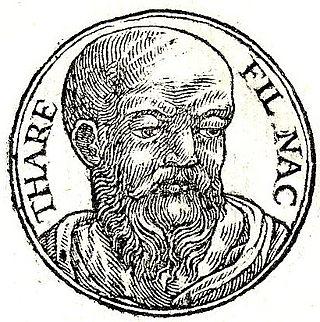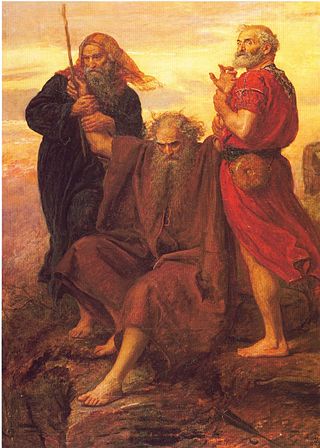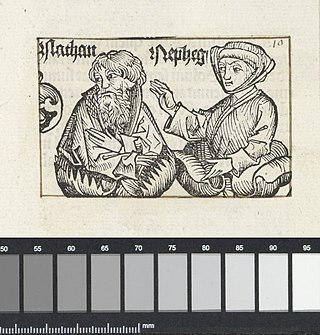Related Research Articles
The Book of Chronicles is a book in the Hebrew Bible, found as two books in the Christian Old Testament. Chronicles is the final book of the Hebrew Bible, concluding the third section of the Jewish Tanakh, the Ketuvim ("Writings"). It contains a genealogy starting with Adam and a history of ancient Judah and Israel up to the Edict of Cyrus in 539 BC.

Terah or Terach is a biblical figure in the Book of Genesis. He is listed as the son of Nahor and father of the patriarch Abraham. As such, he is a descendant of Shem's son Arpachshad. Terah is mentioned in Genesis 11:26–27, Book of Joshua 24:2, and 1 Chronicles 1:17–27 of the Hebrew Bible and Luke 3:34–36 in the New Testament.

Caleb is a figure who appears in the Hebrew Bible as a representative of the Tribe of Judah during the Israelites' journey to the Promised Land.
Narratives featuring incest can be found in the Hebrew Bible, which contains mentions of various types of sexual relationships. It also lays out rules and regulations with regard to prohibited degree of kinship. These prohibitions are found predominantly in Leviticus 18:7–18 and 20:11–21, but also in Deuteronomy.

Keturah was a wife and a concubine of the Biblical patriarch Abraham. According to the Book of Genesis, Abraham married Keturah after the death of his first wife, Sarah. Abraham and Keturah had six sons. According to Jewish tradition, she was a descendant of Noah's son Japheth.
Haran or Aran is a man in the Book of Genesis in the Hebrew Bible. He was a son of Terah, brother of Abraham, and father of son Lot and daughters Milcah and Iscah. He died in Ur of the Chaldees. Through Lot, Haran was the ancestor of the Moabites and Ammonites.

Hur was a companion of Moses and Aaron in the Hebrew Bible. He was a member of the Tribe of Judah. His identity remains unclear in the Torah itself, but it is elaborated in rabbinical commentary.

Nathan was the youngest son among four or five children born to King David and Bathsheba in Jerusalem if names were written in order in the Bible. He was a younger brother of Shammuah and Shobab, and Solomon who was the second oldest child of Bathsheba. The first son died before he could be named.
Dedan has several different meanings in the Hebrew Bible. Dedan was an oasis and city-state of north-western Arabia. The people of Dedan are called Dedanim or Dedanites. Dedan is also the name of the son of Raamah and the son of Jokshan.

Manasseh or Menashe was, according to the Book of Genesis, the first son of Joseph and Asenath. Asenath was an Egyptian woman whom the Pharaoh gave to Joseph as wife, and the daughter of Potipherah, a priest of On. Manasseh was born in Egypt before the arrival of the children of Israel from Canaan.
According to Genesis 25:4, Abida was the son of Midian, and the grandson of Abraham and his wife Keturah. He had four brothers: Ephah, Epher, Hanoch and Eldaah.
Ephah was one of Midian's five sons as listed in the Hebrew Bible. Midian, a son of Abraham, was the father of Ephah, Epher, Enoch, Abida, and Eldaah by his wife Keturah. These five were the progenitors of the Midianites.

1 Samuel 1 is the first chapter of the First Book of Samuel in the Old Testament of the Christian Bible or the first part of the Books of Samuel in the Hebrew Bible. According to Jewish tradition the book was attributed to the prophet Samuel, with additions by the prophets Gad and Nathan, but many modern scholars view it as a composition of a number of independent texts of various ages from c. 630–540 BCE. Chapters 1 to 7 of 1 Samuel depict Samuel's life: this chapter focuses on his birth.

1 Chronicles 3 is the third chapter of the Books of Chronicles in the Hebrew Bible or the First Book of Chronicles in the Old Testament of the Christian Bible. The book is compiled from older sources by an unknown person or group, designated by modern scholars as "the Chronicler", and had the final shape established in late fifth or 4th century BCE. This chapter contains the genealogy of unbroken Davidic line from the time of David to the post-exilic period, providing a possibility of the reinstatement of the Davidic monarchy in Jerusalem with its rightful heir, should circumstances allow. It is divided into three parts: (1) the sons of David ; (2) the kings in Jerusalem ; (3) the descendants during and after the exile period, verses 17–24. Together with chapters 2 and 4, it focuses on the descendants of Judah: chapter 2 deals with the tribes of Judah in general, chapter 3 lists the sons of David in particular and chapter 4 concerns the remaining families in the tribe of Judah and the tribe of Simeon. These chapters belong to the section focusing on the list of genealogies from Adam to the lists of the people returning from exile in Babylon.

1 Chronicles 2 is the second chapter of the Books of Chronicles in the Hebrew Bible or the First Book of Chronicles in the Old Testament of the Christian Bible. The book is compiled from older sources by an unknown person or group, designated by modern scholars as "the Chronicler", and had the final shape established in late fifth or fourth century BCE. This chapter and two subsequent ones focus on the descendants of Judah, where chapter 2 deals with the tribe of Judah in general, chapter 3 lists the sons of David in particular and chapter 4 concerns the remaining families in the tribe of Judah and the tribe of Simeon. These chapters belong to the section focusing on the list of genealogies from Adam to the lists of the people returning from exile in Babylon.